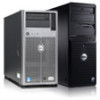Dell PowerEdge External Media System 1434 Improving NFS performance on HPC clu - Page 5
Executive Summary
 |
View all Dell PowerEdge External Media System 1434 manuals
Add to My Manuals
Save this manual to your list of manuals |
Page 5 highlights
Improving NFS Performance on HPC Clusters with Dell Fluid Cache for DAS Executive Summary Most High Performance Computing clusters use some form of a Network File System (NFS) based storage solution for user data. Easy to configure and administer, free with virtually all Linux distributions, and well-tested and reliable, NFS has many advantages. Use of nearline SAS drives for backend storage provides large capacity and good performance at a reasonable cost, but with an inherent performance limitation for random I/O patterns. This technical white paper describes how to improve I/O performance in such a NFS storage solution with the use of Dell Fluid Cache for DAS (DFC) technology. It describes the solution and presents cluster-level measured results for several I/O patterns. These results quantify the performance improvements possible with DFC, especially for random I/O patterns. This white paper also includes a how-to recipe in the Appendix that provides step-by-step instructions on building the solution. 5














